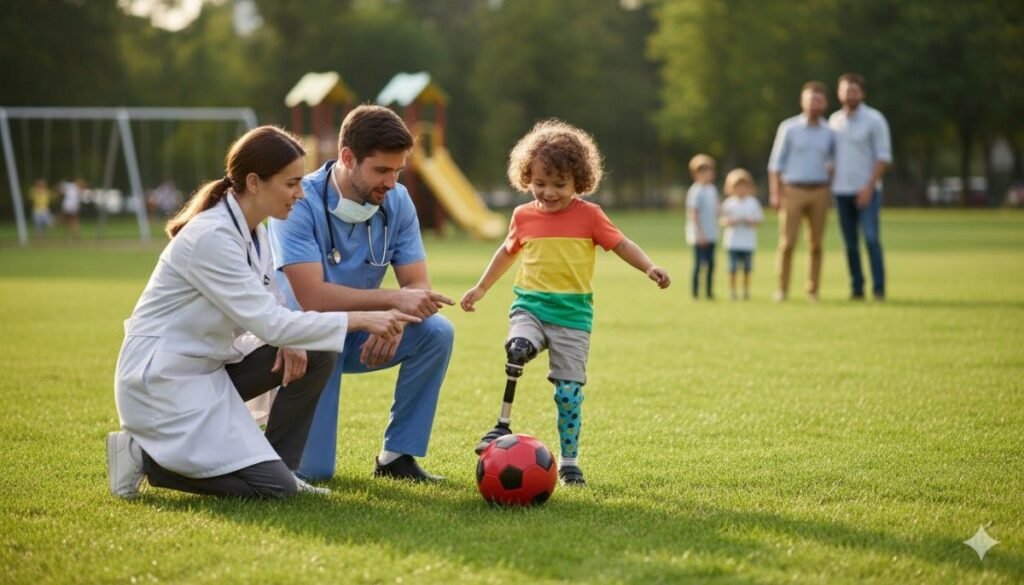Children are full of energy, dreams, and curiosity. When one loses a limb — whether from an accident, infection, or a birth condition — that energy can suddenly turn into fear and confusion. For parents, it’s heartbreaking. For doctors, it’s one of the toughest situations to guide.
Pediatric amputation isn’t only about surgery. It’s about rebuilding a child’s confidence and helping them return to play, school, and laughter. Every small decision made during treatment — from when to introduce a prosthetic to how to guide rehabilitation — shapes the child’s future independence and emotional health.
For pediatricians and orthopedists, understanding the right timing for prosthetic fitting is critical. Introduced too early, a prosthetic might be uncomfortable or underused. Introduced too late, it can delay motor development, body balance, and emotional acceptance.
In this article, we’ll explore the entire journey — from amputation to recovery — through the lens of early prosthetic intervention. You’ll learn how timing impacts growth, how to prepare both parents and children, and how modern prosthetic technology is reshaping pediatric care in India.
Because when done right, a prosthesis isn’t just a device — it’s a bridge back to childhood.
Understanding Pediatric Amputation
How Pediatric Amputation Differs from Adult Cases

When an adult loses a limb, the body has already stopped growing. The bones, muscles, and nerves are mature, and rehabilitation focuses mostly on strength and balance. But in children, everything is still developing. Their bones grow, their muscles stretch, and their coordination evolves each year.
That’s why pediatric amputation is never a one-time procedure. The child’s body will keep changing, and so must their prosthesis. What fits perfectly today might feel too small or misaligned in a few months.
Children also adapt faster than adults. Their brains are more flexible, their muscles rewire quickly, and they often accept prosthetics with less hesitation — if introduced at the right time. But this window of readiness is small, and missing it can affect how well they adjust later.
Common Causes of Amputation in Children
The causes of pediatric amputation can vary widely. Some are congenital, meaning the child is born with a missing or underdeveloped limb. Others are acquired later due to trauma, infection, or cancer.
In congenital limb differences, the challenge is not recovery from loss but learning movement patterns that the child never had. For acquired amputations, the focus shifts to helping the child accept and adapt to a new physical reality.
For doctors, understanding the emotional and developmental stage of the child is just as important as understanding the surgical details. A toddler needs a different kind of introduction than a teenager.
Growth and the Changing Residual Limb
One of the most unique challenges in pediatric amputation is growth. As a child grows taller, the residual limb (stump) also changes in length, shape, and muscle tone.
This means frequent adjustments or replacements of the prosthesis are needed. The socket, which connects the limb to the prosthetic, must fit snugly without causing pressure or pain. A loose or tight fit can lead to skin breakdown, poor posture, or loss of interest in using the limb.
Pediatric orthopedists and prosthetists must therefore plan ahead, scheduling regular follow-ups and anticipating when a new fitting will be needed. Early coordination prevents frustration and ensures the child keeps progressing confidently.
The Importance of Early Prosthetic Timing
The Window of Opportunity
There’s a critical window in every child’s growth when the brain is most adaptable to learning movement patterns. Introducing a prosthetic during this phase helps the child see it as a natural part of their body rather than an external tool.
If doctors wait too long, the child may grow accustomed to using one side of the body more than the other. This imbalance can lead to long-term postural issues or reluctance to use a prosthesis later.
Early prosthetic timing isn’t about rushing — it’s about recognizing readiness. When the wound has healed, when the child shows curiosity, and when emotional acceptance begins — that’s the perfect time to start.
Physical Readiness vs Emotional Readiness
Physical readiness refers to the healing of the residual limb and the child’s ability to bear weight or perform movement. Emotional readiness is the willingness to explore, touch, and trust the prosthetic.
Sometimes the body heals before the mind is ready. In such cases, forcing early fitting can create resistance. The child might reject the prosthetic simply because it feels foreign.
That’s why pediatricians play a key role — they know the child’s behavior, their fears, and their comfort level. By working closely with orthopedists and prosthetists, they can decide when both body and mind are ready for the next step.
The Role of Early Stimulation
For very young children, especially those with congenital limb differences, early stimulation is essential. This means encouraging them to use both sides of their body during play, even before fitting a prosthetic.
For example, if a child has a missing arm, caregivers can motivate them to reach, crawl, or hold toys using both sides. These activities train the brain to expect movement from both limbs.
When a prosthetic is introduced later, the brain already “knows” what to do. It accepts the new limb naturally and integrates it faster.
Preventing Developmental Delays
Delaying prosthetic fitting doesn’t only affect balance — it can slow down overall development. Children who go too long without using both sides of the body might take longer to crawl, walk, or run.
This delay can also affect confidence. A child who struggles to keep up with peers may become shy or withdrawn. Early prosthetic fitting helps prevent this emotional setback, allowing the child to participate fully in play and school.
For doctors, early timing is not just about mobility; it’s about emotional growth, social confidence, and equality in development.
The Role of Pediatricians and Orthopedists
Building an Interdisciplinary Team
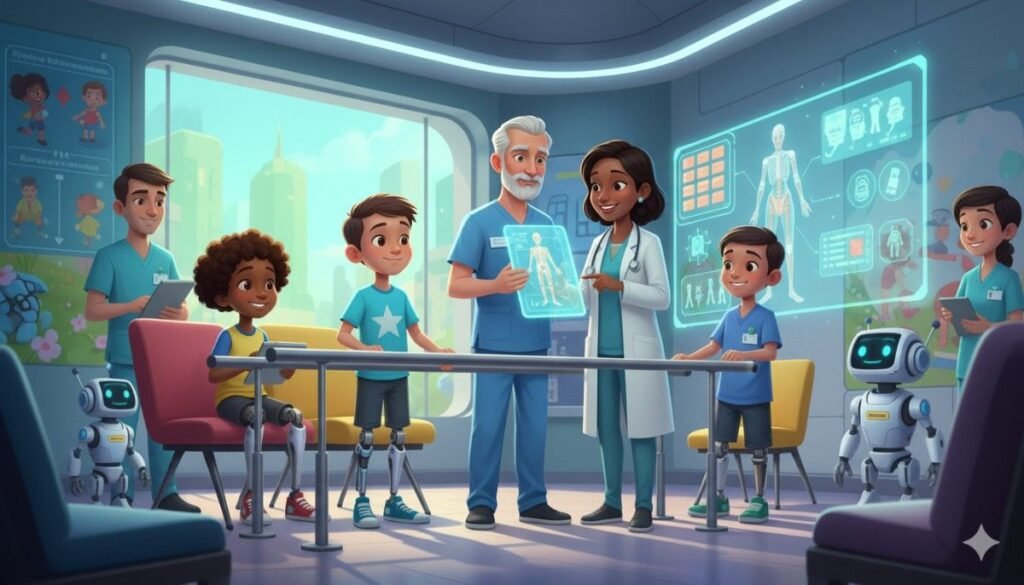
Pediatric amputation care works best when doctors don’t work alone. Pediatricians, orthopedists, prosthetists, physiotherapists, and psychologists must come together from the beginning.
Each professional brings a unique view. The pediatrician understands the child’s growth and emotional state. The orthopedist ensures surgical healing and alignment. The prosthetist designs comfort and usability. The physiotherapist trains function and strength.
Together, they create a seamless care journey that focuses not just on the limb, but on the whole child.
Coordinating Care After Surgery
Once the surgery is done, the countdown begins. The residual limb needs time to heal, but the team must stay alert for when it’s ready for fitting.
Pediatricians monitor wound healing, while orthopedists ensure bone stability. The prosthetist begins early assessment — measuring, planning socket design, and preparing the family for the fitting process.
This coordination reduces waiting time and anxiety. When the moment comes, everyone is ready — the limb, the team, and most importantly, the child.
Preparing the Parents
Parents are often more anxious than the child. They fear pain, cost, and how their child will adapt. Some even hesitate to consider prosthetics early, thinking it might burden their child.
Doctors play a huge role in education here. When parents understand how prosthetics help with balance, play, and growth, their fear fades.
Showing them examples, sharing success stories, and allowing them to meet other families helps them feel supported and hopeful.
Recognizing Emotional Cues
Children express discomfort differently. Some may cry, others may simply stop using the prosthesis. Pediatricians are best placed to notice these cues because they see the child regularly.
By picking up on early resistance, they can coordinate with prosthetists to adjust fit or training techniques. This small attention prevents frustration and keeps the child engaged in therapy.
Tracking Growth and Replacements
Because children grow fast, their prosthetic needs will change often. Pediatric orthopedists must schedule routine assessments to track stump growth and muscle tone.
A good practice is to reassess every six to twelve months, or sooner during growth spurts. Keeping pace with the child’s development ensures the prosthetic always supports them rather than hinders them.
The Medical Considerations of Early Fitting
Surgical Healing and Skin Health
Before any prosthetic fitting, the wound must be fully healed and the skin intact. For children, skin is thinner and more sensitive, so extra care is needed.
Doctors should look for redness, swelling, or any sign of infection. Once healing is complete, gentle compression can help shape the limb and reduce swelling — preparing it for a good prosthetic fit.
Healthy skin ensures comfort and prevents early rejection of the prosthesis due to pain or irritation.
Stump Shaping and Volume Management
A well-shaped residual limb makes prosthetic fitting smoother. After surgery, elastic bandages or shrinker socks are often used to mold the limb into a uniform shape.
This step is especially important for young children, as uneven stump growth can cause discomfort later. Proper shaping also improves balance and weight distribution once the prosthesis is attached.
Muscle Strength and Control
Before fitting, the child’s muscles must be strong enough to handle the prosthesis. Physiotherapists can guide parents on fun, simple exercises — like reaching, pushing, or crawling — that strengthen core and limb muscles.
For upper-limb amputees, learning to control the shoulder and residual arm muscles prepares them for myoelectric prosthetics later. For lower-limb amputees, early standing and balancing activities build readiness for walking aids.
Avoiding Contractures
Contractures — or muscle tightening — are a common issue when joints are not moved regularly after surgery.
For example, a child with an above-knee amputation may keep the hip bent too often, making it harder to use a prosthetic later. Early physical therapy and gentle stretching prevent this problem, keeping the limb flexible and ready.
Timing the First Prosthesis
For most children, the first prosthesis can be introduced once the wound has healed and swelling has stabilized — usually within six to twelve weeks after surgery.
For congenital cases, fitting can begin as early as six months of age, when the child starts sitting and exploring.
The goal is not perfection but familiarity. Early fitting helps the child see the prosthesis as part of normal life, not as something to be feared.
The Journey of Pediatric Prosthetic Fitting
The First Fitting Experience

The first time a child tries on a prosthetic limb is often emotional for everyone in the room. Parents watch with nervous hope, doctors observe carefully, and the child is caught between curiosity and confusion.
The goal of this first session is not perfection. It’s to build comfort, trust, and a sense of excitement. The prosthetic must feel light, smooth, and easy to control. For very young children, it should almost feel like a toy that invites exploration rather than a medical device.
A gentle, playful approach works best. Let the child touch the prosthetic, tap it, or use it during playtime. The more familiar it feels, the faster the brain accepts it as part of the body.
The Role of Family in Adaptation
Parents are the strongest allies in rehabilitation. Their patience, tone, and encouragement shape how the child reacts. If they show confidence, the child mirrors it. If they show anxiety, the child senses fear.
It’s vital that families are involved in every stage — fitting, adjustments, and practice. Encouraging small daily challenges, like picking up a toy or taking a few steps, builds muscle memory and motivation.
Many parents find it helps to turn therapy into play. Instead of “practice time,” they can call it “game time.” This shift in mindset removes pressure and turns the process into fun learning.
Making Prosthetics a Natural Part of Life
Children don’t see prosthetics the way adults do. They’re less focused on appearance and more on function. If it helps them play, climb, draw, or run, they’ll accept it quickly.
That’s why introducing the prosthesis during natural routines — like playtime, eating, or drawing — is important. It becomes part of daily life, not an external thing that’s “added.”
When a prosthesis is introduced early, children grow up with it as part of their identity. They see it as normal, not something to hide. This early normalization has long-term emotional benefits.
Adjusting Fit and Function Over Time
As the child grows, the prosthesis must evolve too. A limb that fits perfectly one year might pinch or feel loose the next. Regular assessments ensure the socket still fits well and movement remains smooth.
Every adjustment should focus on comfort first. If the prosthesis hurts, the child will stop using it, leading to imbalance or disuse. Keeping the fitting process positive encourages lifelong acceptance.
Modern prosthetic systems often allow modular adjustments, so small changes can be made without replacing the entire limb. This makes it easier for parents and more affordable for families.
Training and Physical Therapy
Rehabilitation doesn’t end at fitting — it starts there. Training sessions help the child learn how to move naturally, balance, and control the prosthesis with precision.
Therapists use age-appropriate exercises. For toddlers, it’s play-based: reaching for toys, crawling, or stacking blocks. For older children, it includes balance drills, walking on uneven ground, or fine-motor tasks.
The goal is independence, not perfection. Every milestone — from taking a first step to tying shoelaces — brings a sense of achievement that fuels confidence.
Emotional Adaptation and Identity
Children are emotionally resilient. But even so, some may face moments of frustration or self-doubt, especially when comparing themselves with peers.
This is where parents and doctors must stay patient and consistent. Acknowledge the child’s feelings but remind them gently of what they’ve achieved. Introducing them to other children with prosthetics can help them feel seen and understood.
Positive role models — athletes, artists, or students with prosthetics — inspire children to dream bigger. When they see someone like them thriving, their self-image changes from “different” to “capable.”
The Importance of School and Social Inclusion
Returning to school is often a major milestone. Teachers and classmates play a big role in shaping how a child feels about their prosthesis.
Doctors and parents can help by briefing teachers beforehand. Simple explanations about how the prosthesis works and what the child may need can prevent awkwardness or teasing.
When children feel accepted at school, they use their prosthetics more confidently. Inclusion is powerful — it turns a device into a part of identity.
Common Challenges and How to Overcome Them
There will be hurdles. Sometimes the prosthesis feels heavy. Sometimes a child refuses to wear it for a few days. Other times, skin irritation might occur.
These moments are normal. What matters is the response. Instead of scolding or forcing, offer understanding. Ask what feels uncomfortable, and involve the prosthetist to fix it.
Encouragement works better than pressure. A gentle reminder that the prosthetic helps them run faster or play longer often motivates a child more than rules or deadlines.
The Transition to Advanced Prosthetics
As children grow, their physical demands and curiosity grow too. Around adolescence, many begin asking for more advanced prosthetics — ones that move faster, grip better, or look more natural.
This stage is crucial because it reinforces independence. Teenagers who choose their prosthetics feel empowered. They’re no longer passive users; they’re active participants in their recovery journey.
Myoelectric prosthetics, like the Grippy™ Bionic Hand by RoboBionics, respond to muscle signals and allow fine, natural movement. These devices give older children more control, letting them write, hold, or even use digital devices comfortably.
Technology Meets Growing Needs
Modern prosthetic technology has made it easier to match children’s energy. Lightweight materials like carbon fiber reduce fatigue, while smart sensors enhance control and response.
For lower-limb amputees, microprocessor-controlled knees and feet help maintain balance during running or climbing. For upper-limb users, tactile feedback systems simulate touch — making the prosthesis feel more “alive.”
In India, locally made devices are closing the gap between affordability and innovation. Companies like RoboBionics have proven that world-class prosthetics can be made accessible, giving Indian children global-level technology at a fraction of the cost.
The Value of Regular Follow-Up
Follow-up is not a formality; it’s an essential part of pediatric prosthetic care. Each visit helps monitor fit, growth, and emotional adjustment.
Doctors can use these visits to celebrate progress. Praising how well a child walks or uses their limb reinforces positive behavior. Parents should be encouraged to note any discomfort or behavioral change — sometimes a small fix can restore full enthusiasm.
Early detection of issues prevents long gaps in prosthesis use and keeps the child’s development on track.
Balancing Growth and Functionality
For fast-growing children, prosthetic planning must anticipate change. Pediatric orthopedists should coordinate closely with prosthetists to forecast when replacements will be needed.
Using adjustable sockets or modular limbs allows simple modifications without replacing the entire system each time. This approach saves families cost and minimizes disruption.
At every growth phase, the focus remains the same — ensuring that the child can move, play, and explore freely.
Encouraging Lifelong Comfort and Acceptance
Early positive experiences create lasting habits. A child who learns to love their prosthesis at a young age is far more likely to use it consistently into adulthood.
Doctors and parents can nurture this relationship by making the prosthesis a symbol of strength. Celebrate milestones, photograph progress, and highlight achievements that involve using the prosthetic.
These emotional reinforcements transform the device from something “medical” into something personal and empowering.
Role of Cultural and Social Perception
In many communities, disability still carries stigma. Children might face unwanted attention or questions that make them feel self-conscious.
This is why public awareness matters. When teachers, relatives, and peers understand prosthetics as tools of empowerment, social acceptance grows naturally.
Community programs, school sessions, and local media can all play a part in normalizing prosthetic use and celebrating inclusion.
The Role of Early Education and Counseling
Before the first fitting, families often need emotional counseling as much as technical guidance. Doctors can use this opportunity to set realistic expectations and explain the adaptation process clearly.
When parents know that challenges are normal and progress takes time, they’re better equipped to stay patient and encouraging.
This support system helps children adapt faster and view the prosthesis not as a burden, but as a helpful friend that grows with them.
Preparing for the Future
Every child fitted with a prosthesis will eventually face transitions — from school to college, from pediatric to adult care, from basic to advanced technology.
Planning ahead ensures these transitions happen smoothly. Doctors can prepare parents by explaining when upgrades might be needed or how to access training and support later in life.
Encouraging independence from the start helps children approach adulthood with confidence and control over their journey.
Clinical Decision-Making in Pediatric Amputation
The Doctor’s Responsibility
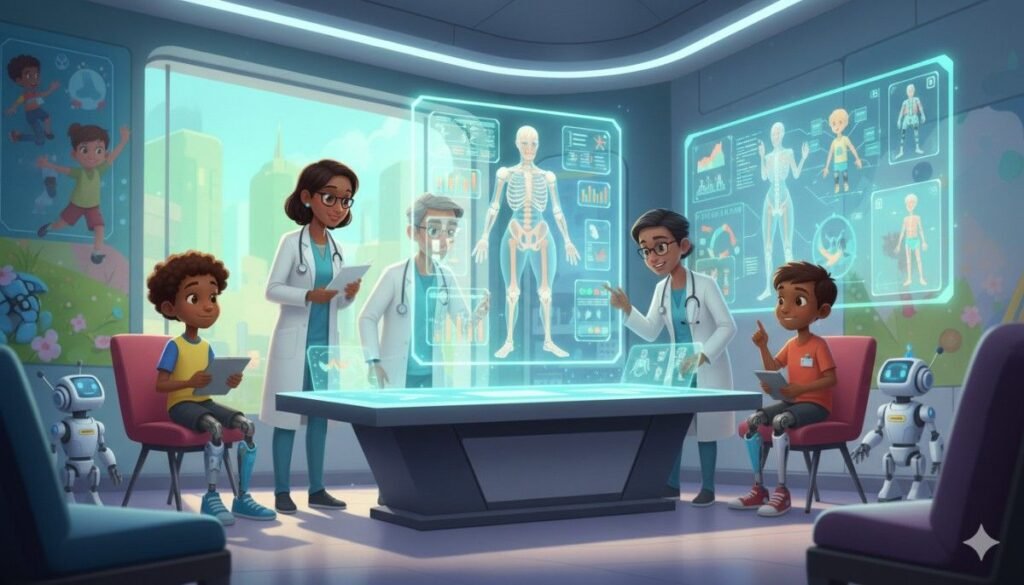
When it comes to pediatric amputation, doctors don’t just treat a limb — they shape a life. Every decision made during and after surgery has long-term impact on how a child grows, learns, and lives.
For pediatricians and orthopedists, the key responsibility lies in balancing surgical precision with emotional sensitivity. Timing matters. Guidance matters. The tone of voice, the words used, and the encouragement offered — all influence how the child and family handle recovery.
Children are quick learners. But they’re also quick to form emotional associations. If the first experience with a prosthesis is painful or rushed, they may reject it. If it’s gentle, playful, and positive, they’ll embrace it wholeheartedly.
Knowing When to Recommend a Prosthesis
The timing of prosthetic introduction is both art and science. It’s about understanding healing patterns, emotional readiness, and growth potential.
A prosthesis should never be delayed so long that the child learns to live one-sidedly. Nor should it be forced before the body and mind are ready.
Generally, prosthetic fitting can begin as soon as the wound heals, swelling subsides, and the child is curious about using both limbs. For congenital cases, this can mean fitting as early as when the baby begins sitting or reaching.
Doctors must rely not only on test results and measurements but on observation — how the child moves, responds, and expresses interest. These subtle cues often reveal more than any chart.
Aligning Medical and Developmental Goals
Medical healing is one part of recovery; developmental progress is the other. The earlier a prosthesis is fitted, the more naturally it integrates with the child’s motor skills.
Pediatric orthopedists should coordinate with therapists to ensure that prosthetic use supports milestones like crawling, walking, or grasping. Pediatricians, who see the child more regularly, can monitor how the prosthesis affects social and emotional growth.
When both medical and developmental goals align, the result is not just recovery — it’s wholeness.
Recognizing the Signs of Readiness
Doctors often wonder how to recognize when a child is ready for a prosthesis. There are several subtle indicators.
A child who starts showing curiosity about their missing limb — touching it, asking questions, or imitating motion — is emotionally ready.
A child who can sit, balance, or move the residual limb without pain is physically ready.
When these signs appear together, it’s time to act. Early recognition helps doctors introduce prosthetics before hesitation sets in, ensuring smooth adaptation.
The Ethics of Timing and Intervention
Balancing Compassion and Realism
Every parent hopes their child will recover completely. Doctors must honor that hope — but also guide it with honesty.
When parents ask, “Will my child ever walk or play again?” the most compassionate answer is truthful reassurance: “Yes, with the right support, your child can do everything — it may just look a little different.”
Ethical communication means avoiding extremes — neither false hope nor unnecessary fear. It’s about painting a picture of possibility that’s rooted in medical reality.
Informed Consent and Shared Decision-Making
Parents have the final say, but their decisions must be informed ones. Doctors should clearly explain what prosthetic fitting involves — the process, the follow-up care, and the expected challenges.
By engaging parents in decision-making early, doctors foster trust. Parents who understand the “why” behind each step are more patient, cooperative, and supportive during rehabilitation.
Children too, even at young ages, should be part of the conversation. When they feel included, they respond with more curiosity and less fear.
Avoiding Delay from Emotional Hesitation
Sometimes, parents delay prosthetic fitting out of emotional protection — they fear causing pain or stress to their child. While the intention is pure, the outcome can backfire.
The longer the delay, the harder it becomes for the child to adapt physically and emotionally. Early introduction helps normalize the prosthesis before self-consciousness sets in.
It’s the doctor’s role to gently but firmly guide families toward timely action, showing them that early fitting is a gift, not a risk.
The Emotional Duty of the Doctor
Pediatric amputation care is more than technical skill; it’s emotional stewardship. The way a doctor communicates hope can redefine how a family perceives the entire journey.
A calm tone, kind explanations, and small gestures of reassurance build trust faster than any medical term. When a doctor says, “We’ll get through this together,” the family hears a promise — one that carries them through the hardest days.
The Power of Early Communication
Preparing the Family
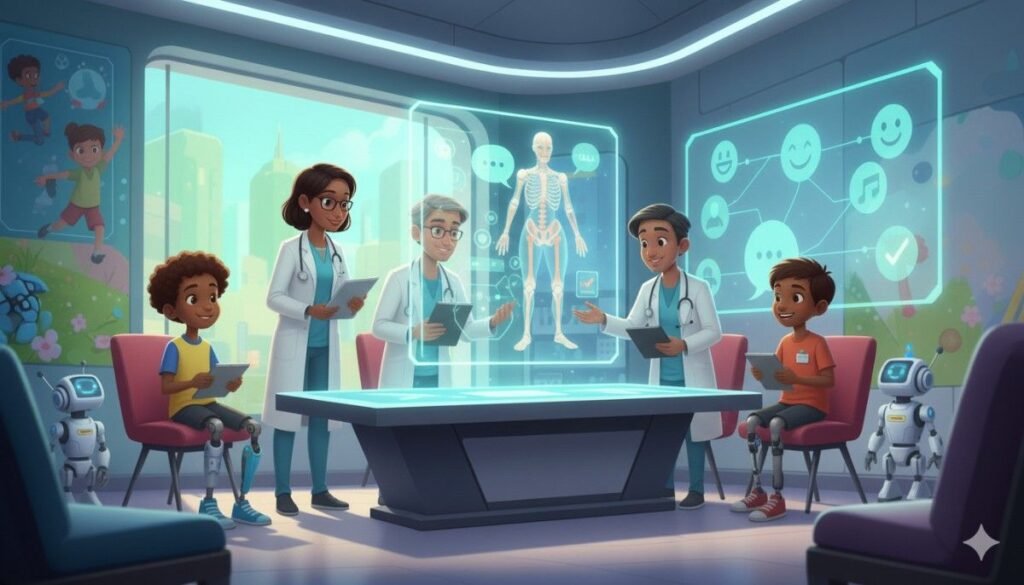
For most parents, amputation feels like a nightmare. Before discussing prosthetics, they need time to process the loss.
Once they’re ready, doctors can begin explaining the next steps with empathy and clarity. Using simple language and visuals helps immensely. Some hospitals use child-friendly models or illustrations to show how prosthetics work, turning fear into curiosity.
It’s important to emphasize that the prosthesis is not a reminder of loss — it’s a tool for possibility. When parents understand this, their conversations with their child become more hopeful and encouraging.
Building Trust with the Child
Children may not always understand medical explanations, but they understand tone. A warm smile, gentle words, and patient listening help them feel safe.
Doctors can build trust through playful interactions — letting the child hold a model prosthetic, explore how it moves, or watch another child use one.
When the first introduction feels positive, future sessions become much easier.
Creating a Language of Encouragement
Words matter deeply. Phrases like “You’re strong,” “You can do this,” and “This will help you play again” plant seeds of resilience.
Doctors should train families and caregivers to use this same encouraging language at home. Children internalize what they hear — when they hear possibility, they believe in it.
Handling Setbacks Gracefully
Every recovery journey has moments of frustration. A child might resist wearing the prosthesis, or parents might feel overwhelmed by costs or appointments.
When this happens, doctors must remind them that setbacks are part of progress. Reassurance — rather than pressure — keeps motivation alive.
Sometimes, connecting families with others who’ve been through the process offers more comfort than words. Shared experience is powerful medicine.
How Modern Prosthetics Are Redefining Pediatric Care in India
A New Era of Accessibility
Not long ago, high-quality prosthetics were unaffordable for most Indian families. Imported devices cost several lakh rupees, putting them far beyond reach.
But local innovation is changing that. Indian companies like RoboBionics are leading the way in designing advanced, affordable, and child-friendly prosthetics.
With over 60 of 64 parts made locally, RoboBionics’ Grippy™ Bionic Hand proves that world-class prosthetics can be made right here in India. This innovation is helping hundreds of families access technology that was once a distant dream.
Lightweight and Kid-Friendly Design
Children need prosthetics that match their pace — light, durable, and easy to control. Heavy devices cause fatigue and frustration.
Modern pediatric prosthetics use lightweight materials and ergonomic designs that let children move naturally. Adjustable sockets allow for growth, reducing the need for frequent replacements.
For upper-limb users, myoelectric systems like Grippy™ detect muscle signals, allowing natural hand movements — opening, closing, and gripping with ease.
The Magic of Sense of Touch Technology
RoboBionics’ Sense of Touch™ system gives children a unique advantage — it lets them “feel” pressure while holding objects. This feedback helps them handle delicate things like pencils, crayons, or water bottles without dropping them.
For a child learning to draw, write, or eat independently, this sense of touch is priceless. It builds confidence and helps them rediscover the joy of everyday tasks.
The Role of Affordability in Early Adoption
Affordability directly affects timing. Families that can access prosthetics early see better outcomes because they don’t delay fitting due to financial stress.
By making devices available between ₹2.15–3 lakh, RoboBionics ensures that early intervention is possible for more families. This affordability bridges the gap between surgery and rehabilitation faster than ever before.
Doctors who know about these accessible options can guide families with greater confidence and empathy.
Collaboration Between Hospitals and Manufacturers
To truly transform pediatric prosthetic care, hospitals and prosthetic companies must work hand-in-hand.
Early referrals to prosthetic specialists help plan surgeries that optimize future fitting. Post-surgery, joint follow-ups ensure smoother rehabilitation and fewer complications.
This integrated model — where technology meets medical care — is redefining pediatric amputation recovery in India.
Redefining Childhood After Amputation
Beyond Survival: Restoring Joy
For children, recovery is not about getting back what was lost; it’s about rediscovering freedom. A well-fitted prosthesis lets them run, climb, draw, and play like before.
When a child realizes they can still do everything they love, their self-image changes instantly. The laughter that returns to a once-quiet home is proof that healing is complete — not just physically, but emotionally.
The Role of Play and Exploration
Play is therapy. Encouraging children to explore their prosthetic through play builds confidence and coordination. Simple activities like stacking blocks, catching a ball, or painting help them learn control effortlessly.
Doctors should remind parents that playtime is not a distraction — it’s a vital part of rehabilitation. Every moment of fun strengthens both body and mind.
The Power of Peer Support
Seeing another child with a prosthesis creates instant connection. It removes the feeling of isolation and replaces it with belonging.
Support groups, hospital meetups, or online communities can make a huge difference. Sharing stories of resilience encourages children to embrace their prosthesis proudly.
Embracing the Future with Pride
The next generation of children with prosthetics in India is growing up differently. They’re more confident, more expressive, and more aware of the technology supporting them.
Thanks to early intervention and modern innovation, they’re not defined by their amputation — they’re defined by their possibilities.
Doctors and parents together are shaping this change, one child at a time.
Conclusion: The Right Time Is Early
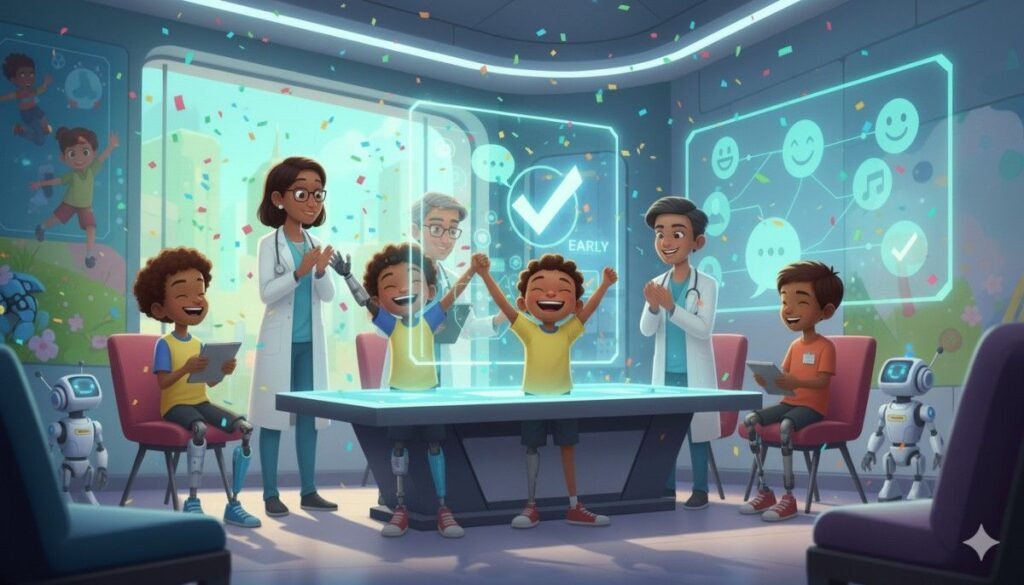
Early prosthetic timing is not just a medical decision — it’s a life decision. It determines how confidently a child walks into the future, how easily they adapt, and how freely they live.
For pediatricians and orthopedists, the message is clear: act early, act collaboratively, and act with compassion.
When prosthetics are introduced at the right moment, they don’t just restore function — they restore childhood. They help children run, draw, laugh, and dream without limits.
At RoboBionics, we believe that every child deserves that chance. Our mission is to make advanced prosthetics accessible, affordable, and full of life — because technology should never be a privilege; it should be a promise.
If you’re a doctor, parent, or caregiver ready to explore early prosthetic solutions for children, we invite you to connect with us.
Book a free consultation or demo at www.robobionics.in/bookdemo — and let’s give every child the freedom to grow, play, and live fully once again.



